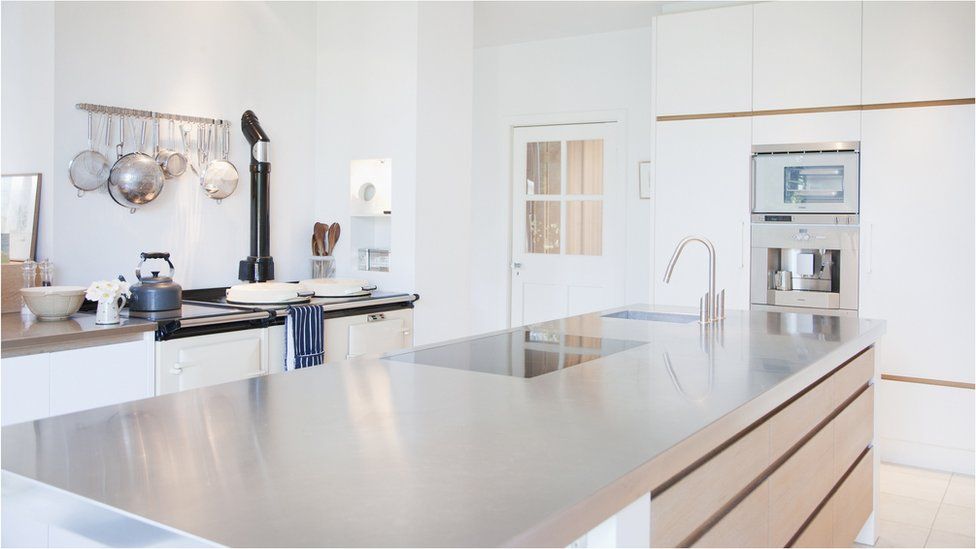The dirtiest place in your kitchen might surprise you...
- Published
- comments

We are clearly a nation that is very keen on cleanliness. Many of us stick antibacterial surface wipes in our shopping baskets (and then sometimes down the drain, helping cause those giant fatbergs).
But, quite apart from the environmental cost, is money spent on antimicrobial wipes money well spent?
Can you really eliminate most of the microbes in your house by wiping down the surfaces, and why would you want to anyway?
There's no doubt some of the germs that lurk in our homes are harmful to us.
You should be extremely careful, for instance, when handling raw meat to ensure you don't spread harmful bacteria around.
The old practice of washing a raw chicken before cooking it is a spectacularly bad one as that is not going to make much impression on the harmful bacteria, while maximising the chances of spraying around something that will make you or your family very ill indeed.
So, don't wash chickens. But how effective is using antibacterial wipes on surfaces?
Waste of time?
To find out, the Trust Me I'm a Doctor team recruited three families and gave them a removable kitchen worktop.
At the start of our test we asked all our volunteer families to give their worktops a thorough clean with antibacterial wipes.
After that, we asked them to use their kitchens as normal, but avoid using the worktops. They did, however, take regular swabs of the worktops, so we could see how long they remained germ-free.
We then sent those swabs to microbial physiologist Lynn Dover, at Northumbria University, in Newcastle, to be analysed. So what did he find?
You might also be interested in:
"The first samples we looked at were taken one hour after the worktop had been wiped, and there was already evidence of bacteria and fungal growth," he said.
In other words, almost immediately after disinfecting the surfaces, microbes had already begun to re-colonise the worktops.
"Samples taken 12 hours after being wiped showed quite dramatic growth," Lynn said, "lots of different types of fungi."
So if you are using antibacterial products in the hope of keeping microbes at bay, you may well be wasting your time and your money.
Not only will they grow back, fast, but the vast majority of the microbes that live in our houses are harmless, and some are even important for maintaining good health.
Handles and holders
Worrying unduly about surfaces may, anyway, be missing the point because kitchen surfaces are not necessarily where most harmful microbes lurk.
A study by NSF International in which 22 families were asked to swab 30 everyday household items ranging from kitchen surfaces to mobile phones found those most heavily contaminated with coliform bacteria - a family of bacteria that includes E. coli - were, ironically, the dishcloths or sponges used to wipe down surfaces or clean out pans.
In fact it turned out about 75% of dish sponges or wipes were contaminated by coliform bacteria. Other places these bacteria were found included:
- 45% of kitchen sinks
- 32% of counter tops
- 18% of cutting boards
They also swabbed bathrooms, where they found coliform bacteria growing on:
- 27% of toothbrush holders
- 9% of bathroom handles
Although most coliform bacteria are not particularly dangerous, they are commonly used as a marker for more general faecal contamination.
They don't normally get into your kitchen through contact with human faeces, but via raw meat, which is often contaminated with faecal bacteria.
Dishcloths commonly harbour so many of these bacteria because they are warm and moist, ideal breeding ground for germs.
Dr Chuck Gerba, a professor of microbiology at the University of Arizona, who studies how diseases are transferred through the environment, agrees that the kitchen sponge or cloth is almost always the dirtiest thing in your house.
His studies have shown that, compared with the average toilet seat, where there are about 50 bacteria per square inch (6.5 sq cm), there are about 10 million bacteria per square inch on a sponge, and a million on a dishcloth.
In other words, your kitchen sponge may be 200,000 times dirtier than your toilet seat.
If you are worried about nasty bugs in your kitchen, the best thing you can do is keep your dishcloth or sponge as dry as possible and dunk it in bleach once a week.
Good Housekeeping magazine also has some tips on how to clean your sponges - including sticking them in the microwave or dishwasher to kill germs.
When it comes to chopping boards, it is always a good idea to have one for raw meat and one for everything else.
Personally, I use wooden chopping boards, which I scrub down after use with nothing more than soapy water and - I hope - a reasonably clean sponge.
For deeper cleansing use a dash of vinegar, as acetic acid is a good disinfectant.
Trust Me I'm a Doctor is on BBC Two at 20:30 on Wednesday 21 February and will be available on iPlayer afterwards.